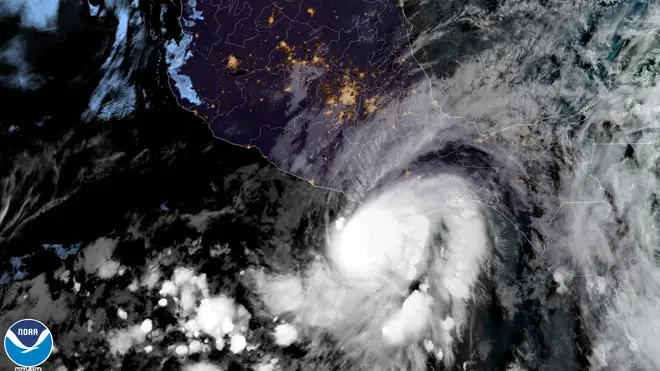
Ian Payne 4am - 7am
31 May 2022, 07:44

Hurricane Agatha made landfall on a sparsely populated stretch of small beach towns and fishing villages in southern Mexico on Monday afternoon.
A hurricane has made history as the strongest recorded to come ashore in the eastern Pacific in May – blasting at 105mph.
Hurricane Agatha made landfall on a sparsely populated stretch of small beach towns and fishing villages in southern Mexico on Monday afternoon.
After hitting the Oaxaca state as a strong category two hurricane, it quickly lost power as it moved inland over the mountainous interior.
Agatha was then downgraded to a tropical storm late on Monday, with its sustained winds down to 70mph.
12:30 pm. In Playa Agua Blanca, a tiny town between Puerto Escondido & Mazunte. Really trying to nail the center of #Hurricane #AGATHA . Tough chase turf, let's just say. #Mexico pic.twitter.com/L3zMzwMfdh
— Josh Morgerman (@iCyclone) May 30, 2022
The US National Hurricane Centre said the storm should dissipate overnight, but warned that heavy rains still posed a threat.
Howling winds and downpours whipped palm trees and drove tourists and residents into shelters.
Oaxaca state’s civil defence agency showed families hustling in a shelter in Pochutla and a rock and mud slide that blocked a motorway.
Heavy rain and big waves lashed the beach town of Zipolite, long known for its clothing-optional beach and bohemian vibe.
“There is a lot of rain and sudden gusts of strong wind,” said Silvia Ranfagni, manager of the Casa Kalmar hotel in Zipolite.
4pm CDT 30 May – #Hurricane #Agatha has made landfall just west of Puerto Angel, Mexico, with maximum sustained winds of 105 mph.
Since record keeping began in 1949, this is the strongest hurricane to make landfall in May along the Pacific coast of Mexico. pic.twitter.com/dUraseRoDe
— NHC Eastern Pacific (@NHC_Pacific) May 30, 2022
Ms Ranfagni, who decided to ride out Agatha at the property, said, “You can hear the wind howling.”
In the surfing town of Puerto Escondido, people took shelter and put up plywood to prevent windows from breaking in the strong winds.
The government’s Mexican Turtle Centre — a former slaughterhouse turned conservation centre in Mazunte — closed to visitors because of the hurricane.
Agatha only formed on Sunday and quickly gained power.
#Agatha has made landfall. With a peak wind speed of 105 mph, it's…
– #Mexico 's strongest hurricane landfall on record before June 15
– Earliest Category 2 #hurricane landfall of any storm in the HURDAT2 database, Atlantic or East Pacific (1863's "Amanda" is unlisted) pic.twitter.com/asI9L17vSa
— Jake Carstens (@JakeCarstens) May 30, 2022
It is the strongest hurricane on record to make landfall in May in the eastern Pacific, said Jeff Masters, meteorologist with Yale Climate Connections and the founder of Weather Underground.
He said the region’s hurricanes typically get their start from tropical waves coming off the coast of Africa.
“Since the African monsoon typically does not start producing tropical waves until early or mid-May, there simply aren’t enough initial disturbances to get many eastern Pacific hurricanes in May,” Mr Masters wrote in an email.
“In addition, May water temperatures are cooler than they are at the peak of the season and wind shear is typically higher.”